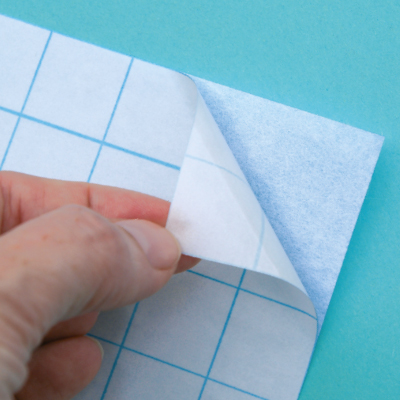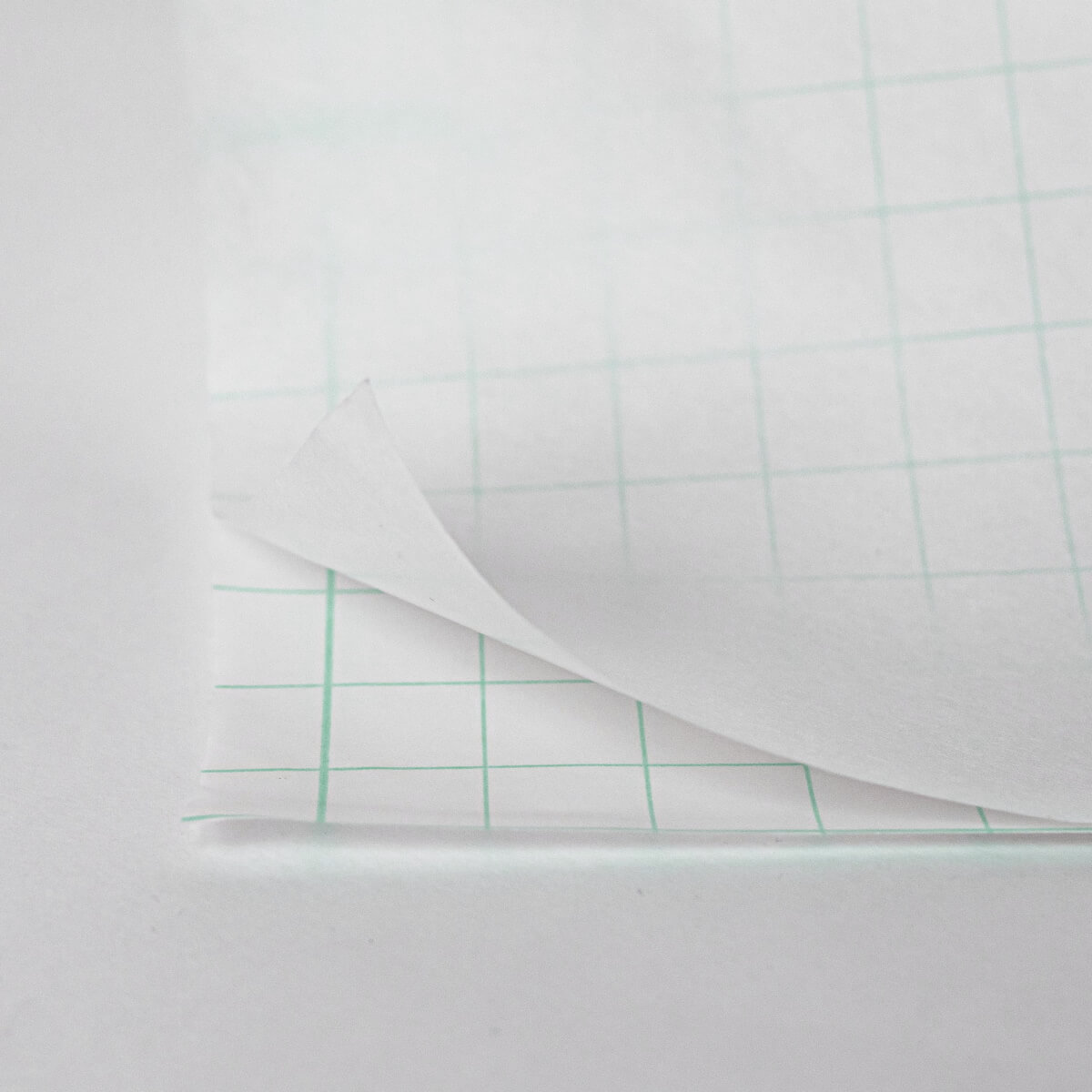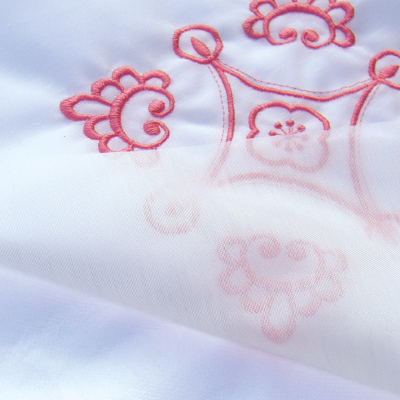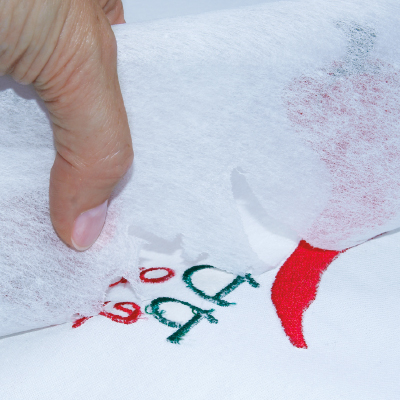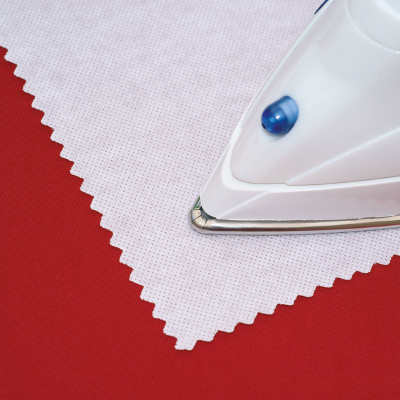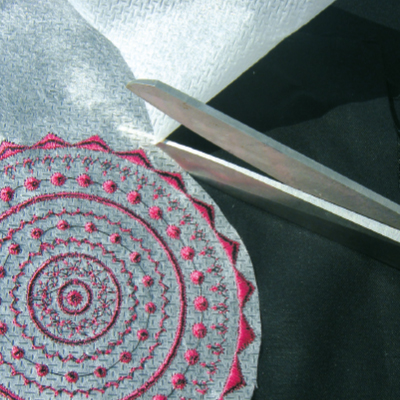Non-wovens
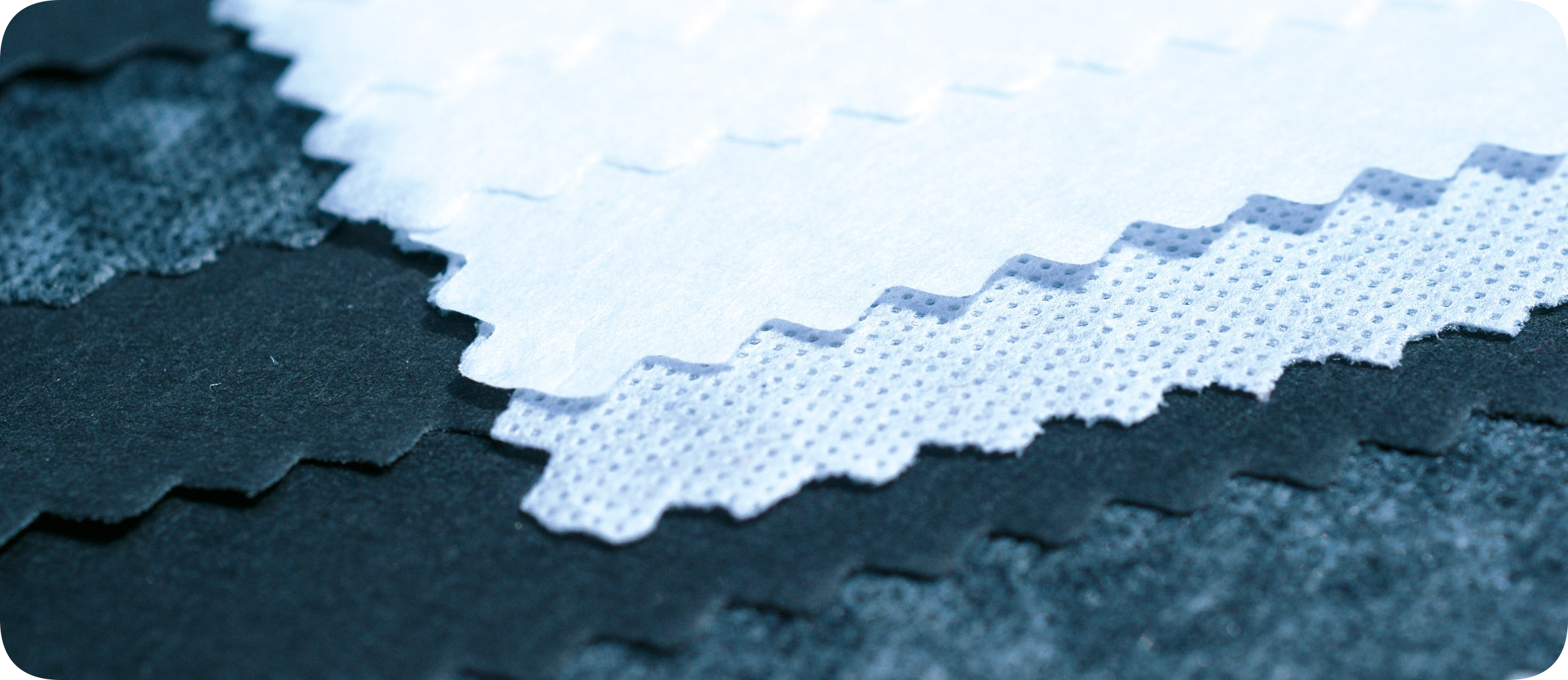
Infos Non-wovens
Product overview Embroidery Backings | Oeko-Tex Certificates | Productinfo Stiffy
Nonwovens - The perfect support for every fabric!
A nonwoven also called stabilizer or backing is used to stabilize the fabric during the embroidery process.
It also has a stabilizing effect once the fabric has been embroidered.
It influences wearing comfort, care properties such as washing and ironing, etc.
It is best to hoop your fabric and stabilizer together in the hoop.
This guarantees the stability of the fabric during the embroidery process.
1. The FABRIC determines the choice of the right stabilizer:
1.1 Fabric Weight
a) thin fabric, thin stabilizer
b) heavy fabric, strong stabilizer
1.2 Fabric Color
a) light fabric, white stabilizer
b) dark fabric, black stabilizer
1.3 Type of Fabric
a) stretchable fabric, adhesive stabilizer
(iron-on or self-adhesive stabilizer)
b) non-stretchable fabric, see point 1
c) transparent fabrics, water-soluble stabilizer
The rule of thumb is: thin fabric, thin stabilizer - heavyweight fabric, strong stabilizer. If it was only about embroidery, a heavier stabilizer would always ensure the best embroidery result.
Wearing Comfort:
As a rule, embroidered textiles are worn on the body. Therefore, the wearer must be taken into account, not just the embroidery process. A thin fabric should remain thin and light, and the stabilizer should not be bulky or scratchy when worn - hence a thin embroidery backing with a low grammage is recommended. For heavyweight fabrics, stronger stabilizers can be used. Thicker, heavier backings stabilize better during the embroidery process and a thicker backing does not irritate when wearing heavier fabrics.
Weight:
When we talk about "thin" and "thick" stabilizers, we always mean the weight of the embroidery backing. This is calculated in grams per square meter (g/m²). When choosing a stabilizer, don't just pay attention to how it feels. Always look at the grammage as well. The lightest, thinnest backings start at 25 g/m², while the heaviest, thickest backings reach weights of 95 g/m². There are several stabilizer qualities with different weights in between.
Color:
The color of the stabilizer- only white and black (anthracite) stabilizers are available. Colored backings are not available and are also not necessary. A white backing is used for white and light-colored fabrics, a black backing for black, dark-colored fabrics. The stabilizer should be as unnoticeable as possible when wearing a garment, so choose either white or black.
Type of Fabric:
Stretchy textiles (polo shirts, sweatshirts, T-shirts) need more stabilization. You may choose iron-on backings (marked "B"), self-adhesive backings (Filmoplast) or cut-away backings.
Transparent Fabrics:
In all cases where embroidery stabilizers shimmer through the fabric, you may want to use water-soluble backings or heat-soluble films. After embroidering, wash out or iron out the remnants (using an iron).
2. The PRODUCTION METHOD and the FEEL influence the choice of stabilizer:
2.1 Tear-Away Stabilizer
2.2 Cut-Away Stabilizer
2.3 Iron-On Stabilizer
2.4 Self-Adhesive Stabilizer
Some people prefer to tear away, others prefer to cut away after embroidering. The decision is guided by your own feelings but also by the production method.
- A tear-away stabilizer can be removed easily and neatly - but does little for the stability of the embroidery later on - it washes out over time (tempo effect)
- A cut-away stabilizer must be cut back around the embroidery after embroidering - be careful not to cut into the fabric. It stabilizes the embroidery for a lifetime, even after many washes.
- Iron-on stabilizers (marked as “B”-stabilizer) are ironed onto the textile (wrong side of the fabric) before embroidering. The temporary adhesive keeps the fabric in shape during embroidery. Simply tear out after embroidering.
- Self-adhesive stabilizers (Filmoplast) are mounted in the embroidery hoop. Remove the release paper and simply place the fabric on top (do not hoop). This prevents stretchy fabrics from warping during embroidery.
3. The EMBROIDERY DESIGN influences the choice of stabilizer:
3.1 Type of design
a) Small fonts / small motifs or
short stitches, cut-away stabilizers
b) Large motifs or motifs with many stitches,
tear-away stabilizers
The digitized motif also influences the choice of stabilizer.
- Small lettering or very fine embroidery can be damaged when the backing is torn away, the embroidery is practically pulled to the reverse side. This can cause an i-dot to disappear for example. In this case, a cut-away stabilizer would be better.
- Large, more open embroidery motifs (i.e.back of garment motifs) can be embroidered using a tear-away stabilizer. After embroidering, the backing can be torn away from large areas.
Fabric Knowledge – Weights
When considering fabric weight, it is important to know that some materials are heavier than others. You should be particularly aware of this with silk, which is exceptionally light. It doesn't make much sense to compare the fabric weight of different materials. A heavy, luxurious silk fabric - such as duchesse or crêpe marocain - weighs just as much as a light to medium weight linen or cotton.
Of all the materials out there, silk is by far the lightest, followed by wool and cashmere. It may seem strange to think of wool as a lightweight material when it is used for cozy winter clothing, but wool and most other protein-based fibers actually weigh very little by volume. Therefore, a coat made of polyester will weigh you down, while a coat made of pure wool will be light in comparison. Natural, plant-based materials like cotton and linen fall somewhere in the middle. This is followed by viscose and its many variants such as Tencel, Modal and Cupro..
The heavyweights among the materials are synthetic fibers such as polyester. A silk satin dress, aside from its unique feel (how it looks and feels), is as light as a spring breeze, while a polyester satin dress not only doesn't let a breeze through, but is so much heavier that it barely moves when that breeze passes.
The ideal silk fabric for a dress weighs around 80 g/m², while viscose would weigh around 120 g/m² and polyester up to 150 g/m². Similarly, for a flowing, sheer bridal veil, you could use silk at 20 g/m² or an imitation made of polyester at 70 g/m².
A cotton batiste for a blouse should weigh around 90 g/m², a light linen up to 140 g/m², a classic silk charmeuse or crepe around 70 g/m².
Product Knowledge - Stretchy Materials
In the case of knitted fabrics, a distinction is made according to the grammage of the textile. The higher the grammage, the heavier the iron-on stabilizer should be. The grammage (g / m²) indicates how heavy the fabric is. The higher the grammage, the "denser" or heavier the fabric. The fabric thickness can vary greatly depending on the manufacturer, but a few standard values can be used as a guide. For T-shirts, the grammage is around 150 g/m². Sweatshirts are around 270 g/m². Polo shirts are around 190 g/m². So even without touching the fabric, you can get a rough idea of how it feels and how thick or heavy the garment is.
Stretchy fabrics have a certain percentage of elastane added to them. These blends increase comfort and can be worn closer to the body, but must be treated similarly to knitted fabrics when embroidering. They require better reinforcement than non-stretch fabrics.
Jersey fabric is a soft, smooth knitted fabric that can be made from various materials (cotton, viscose, etc.). It is a stretchy, single-faced fabric with a very fine stitch pattern. It looks similar to a woven fabric with a light ribbed pattern. Jersey fabric is mainly used for clothing such as T-shirts and underwear or for bed linen.
The name comes from the island of Jersey, where the fabric was first produced. Fleece is made from 100% polyester and is finely knitted. Fleece knitting creates small stitches on the surface, which can be roughened on both sides. This increases the surface area of the fabric resulting in a soft and warm fabric. The higher the stitch density, the higher the quality. Fleece is also water-repellent and wrinkle-resistant.
Nicky velour fabric usually consists of 80% cotton and 20% polyester. It is stretchy like jersey fabrics and also cuddly soft. The underside/inside is made of polyester, while the top is made of long cotton fibers that are cut open to create the carpet-like look. Nicky fabric is very skin-friendly and comfortable to wear thanks to its high cotton content.
Piqué fabric is characterized by raised fine ribbing giving the cloth a subtle pattern and texture. This creates a "waffle-like" structure, whereby the size of these "waffles" can vary so that the fabric looks finer or coarser. Piqué fabric is a heavy and dense type of fabric. Probably the most popular and best-known item of clothing made from piqué is the polo shirt.
Fine rib fabric is knitted alternately with knit and purl stitches, resulting in a ribbed structure. This is clearly visible when the fabric is stretched. Despite its bad reputation, the advantages cannot be denied. Close-fitting and elastic, fine rib fabric is a perfect choice for making underwear in particular.
Sweatshirt fabric is something very special in the way it is made. On the outside, the fabric is like jersey with a smooth surface; on the inside, a so-called lining thread is knitted in. This makes the fabric appear thicker and heavier than a normal T-shirt fabric. The lining thread on the back is roughened, making the inside of a sweatshirt cozy, soft and warm.
Double rib fabric is produced in a similar way to fine rib fabric, except that two longitudinal ribs lie close together. This makes the fabric thicker and coarser, but also stretchy and firm. It is often used for trimmings and the like. This fabric is very popular for warm underwear, among other things.
Technology - Embroidery Stabilizers
Stabilizer technology is diverse and complex. Embroidery stabilizers are only a small part of the overall nonwoven technology. A distinction is made between special manufacturing processes: Wet, dry and thermal nonwovens. Different fibers are also used, the most common being rayon, viscose and polyester, which are also used in any mixture and processed with completely different binders, each leading to different nonwoven results. New fibers classified as more sustainable are being tested, such as plant fibers made from coconut, pineapple, cotton, etc., as well as recycled polyester fibers.
The fibers used can also be short or long, referred to as the staple length, they can be mixed and differ in direction they are running. If the fibers are all running in one direction, for example, they can be torn lengthwise, but not crosswise; if they are mixed in direction, they can be torn in all directions. In general, the shorter the fibers, the easier it is to tear a nonwoven. The longer the fibers, the more difficult it is to tear.
The arrangement of the stabilizer fibers in the correct density to avoid thick or thin areas within the stabilizer should produce a uniform stabilizer quality. Thin or thick patches in the stabilizer lead to different embroidery results that can be seen and felt. You can see this by holding the stabilizer up to the light: thin areas let more light through, thick areas are more opaque. A "cloudy" fleece should be avoided! A good quality fleece is also characterized by the fact that it always has exactly the same quality across all repeat orders.
All types of stabilizers can also be coated afterwards, either as a film or spot coating (iron-on nonwovens).
The fibers of professional embroidery backings support and stabilize the fabric to be embroidered for the entire duration of the embroidery process. The stabilizer must not tear during embroidery. To ensure that the stitches appear smooth and without distortion, it must be stable from start to finish.
Newspaper or cardboard should not be used as embroidery stabilizer as they perforate extensively during embroidery. They do not provide any support and the dust causes soiling of the embroidery machine.
Ecology - Embroidery Stabilizers
The production of embroidery nonwovens in European nonwoven and paper mills are in accordance with DIN ISO 14001, which includes numerous standards relating to environmental management such as life cycle assessments, environmental indicators and environmental performance assessments. Continuous reduction of emissions, water, waste and energy is guaranteed. The producers are members of EDANA (European Disposable And Nonwoven Association, Brussels)
All STIFFY embroidery stabilizers are certified according to Ökotex Standard 100. With the exception of one type, all embroidery stabilizers are vegan.
Cost Effectiveness
Which stabilizer can be used for the majority of embroideries in the embroidery workshop? For every "most suitable" stabilizer quality, there is at least one other real alternative, which can also be another real alternative for other embroidery jobs. Which fabric types or garments will I have to embroider in the near future - blouses and shirts, T-shirts, jackets, or pants, caps etc. and in what quantity, how many items will have to be embroidered. This results in the need for an embroidery backing that is precisely matched to the product - then the fine-tuning begins.
Die Suche nach der besten Alternative, um mehrere auch unterschiedliche Produkte mit einem nahezu am besten geeigneten Stickvlies unterlegen zu können. In wirtschaftlicher Hinsicht lohnenswert, wenn man eine Vliesqualität für verschieden Aufträge, unterschiedliche Stoffe einsetzen kann. Entscheidend ist bei allen Überlegungen, sobald die Qualität beim Stickergebnis stimmt, immer der Preis.
The rule of thumb here is: the heavier a nonwoven the more expensive it is and the black nonwoven quality is always more expensive than the white variant (dyeing process).
Easy, quick and convenient - pre-cut nonwovens save time and waste.
Remove the packaging film and take the stabilizer from the stack sheet by sheet. Place the pre-cut stabilizer on the embroidery hoop, lay the fabric to be embroidered over it and hoop it. You are ready to start embroidering.

